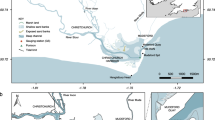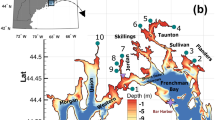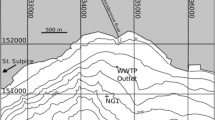Abstract
Estuarine residence time is a major driver of eutrophication and water quality. Barnegat Bay-Little Egg Harbor (BB-LEH), New Jersey, is a lagoonal back-barrier estuary that is subject to anthropogenic pressures including nutrient loading, eutrophication, and subsequent declines in water quality. A combination of hydrodynamic and particle tracking modeling was used to identify the mechanisms controlling flushing, residence time, and spatial variability of particle retention. The models demonstrated a pronounced northward subtidal flow from Little Egg Inlet in the south to Pt. Pleasant Canal in the north due to frictional effects in the inlets, leading to better flushing of the southern half of the estuary and particle retention in the northern estuary. Mean residence time for BB-LEH was 13 days but spatial variability was between ∼0 and 30 days depending on the initial particle location. Mean residence time with tidal forcing alone was 24 days (spatial variability between ∼0 and 50 days); the tides were relatively inefficient in flushing the northern end of the Bay. Scenarios with successive exclusion of physical processes from the models revealed that meteorological and remote offshore forcing were stronger drivers of exchange than riverine inflow. Investigations of water quality and eutrophication should take into account spatial variability in hydrodynamics and residence time in order to better quantify the roles of nutrient loading, production, and flushing.










Similar content being viewed by others
References
Abdelrhman, M.A. 2002. Modeling how a hurricane barrier in New Bedford Harbor, Massachusetts, affects the hydrodynamics and residence times. Estuaries 25(2): 177–196.
Allen, J., P. Somerfield, and F. Gilbert. 2007. Quantifying uncertainty in high-resolution coupled hydrodynamic-ecosystem models. Journal of Marine Systems 64(1–4): 3–14. doi:10.1016/j.jmarsys.2006.02.010.
Bolin, B., and H. Rodhe. 1973. A note on the concepts of age distribution and transit time in natural reservoirs. Tellus 25(1): 58–62.
Bricker, S.B., C.G. Clement, D.E. Pirhalla, S.P. Orlando, and D.R. Farrow. 1999. National estuarine eutrophication assessment: Effects of nutrient enrichment in the nation’s estuaries. Silver Spring: NOAA, National Ocean Service, Special Projects Office and the National Centers for Coastal Ocean Science.
Brooks, D.A., M.W. Baca, and Y.T. Lo. 1999. Tidal circulation and residence time in a macrotidal estuary: Cobscook Bay, Maine. Estuarine, Coastal and Shelf Science 49: 647–665.
Chant, R.J. 2001. Tidal and subtidal motion in a shallow bar-built multiple inlet/Bay system. Journal of Coastal Research 32(Special Issue): 102–114.
Choi, K.W., and J.H.W. Lee. 2004. Numerical determination of flushing time for stratified water bodies. Journal of Marine Systems 50(3–4): 263–281.
Csanady, G.T. 1978. The arrested topographic wave 1. Journal of Physical Oceanography 8: 47–62.
Duarte, C.M. 2002. The future of seagrass meadows. Environmental Conservation 29: 2–206.
Flagg, C.N., J.A. Vermersch, and R.C. Beardsley. 1976. 1974 MIT New England shelf dynamics experiment (March 1974). Data Report, Part II: the moored array, MIT Report 76–1.
Ganju, N.K., S.J. Lentz, A.R. Kirincich, and J.T. Farrar. 2011. Complex mean circulation over the inner shelf south of Martha’s Vineyard revealed by observations and a high-resolution model. Journal of Geophysical Research 116, C10036. doi:10.1029/2011JC007035.
González, F.U.T., J.A. Herrera-Silveira, and M.L. Aguirre-Macedo. 2008. Water quality variability and eutrophic trends in karstic tropical coastal lagoons of the Yucatán Peninsula. Estuarine, Coastal and Shelf Science 76(2): 418–430.
Guo, Q., and G.P. Lordi. 2000. Method for quantifying freshwater input and flushing time in estuaries. Journal of Environmental Engineering 126: 675–683.
Jassby, A., and E.E Van Nieuwenhuyse. 2005. Low dissolved oxygen in an estuarine channel (San Joaquin River, California): mechanisms and models based on long-term time series. San Francisco Estuary and Watershed Science 3(2).
Kennish, M.J., and B. Fertig. 2012. Application and assessment of a nutrient pollution indicator using eelgrass (Zostera marina L.) in Barnegat Bay–Little Egg Harbor estuary, New Jersey. Aquatic Botany 96(1): 23–30.
Kennish, M.J., S.B. Bricker, W.C. Dennison, P.M. Glibert, R.J. Livingston, K.A. Moore, R.T. Noble, H.W. Paerl, J.M. Ramstack, S. Seitzinger, D.A. Tomasko, and I. Valiela. 2007. Barnegat Bay-Little Egg Harbor Estuary: case study of a highly eutrophic coastal bay system. Ecological Applications 17: 3–16.
Lancelot, C., and G. Billen. 1984. Activity of heterotrophic bacteria and its coupling to primary production during the spring phytoplankton bloom in the Southern Bight of the North Sea. Limnology and Oceanography 29: 721–730.
Lathrop, R.G., P. Montesano, and S. Haag. 2006. A multi-scale segmentation approach to mapping seagrass habitats using airborne digital camera imagery. Photogrammetric Engineering and Remote Sensing 72: 665–675.
Liu, Z., H. Wei, G. Liu, and J. Zhang. 2004. Simulation of water exchange in Jiaozhou Bay by average residence time approach. Estuarine, Coastal and Shelf Science 61(1): 25–35.
Miselis J., B. Andrews., R. Baker, W. Danforth, V. DePaul, Z. Defne, L. Feinson, N. Ganju, J. Gibs, R.E. Hickman, A. Lopez, A. Navoy, R. Nicholson, T. Reilly, R. Reiser, F. Spitz, A. Watson, C. Wieben, and T. Wilson. 2012. Characterizing physical, chemical, and biological conditions and processes in the Barnegat Bay-Little Egg Harbor Estuary, New Jersey. 2012 Barnegat Bay Researchers Workshop, Bordentown Township, NJ.
Monsen, N.E., J.E. Cloern, L.V. Lucas, and S.G. Monismith. 2002. A comment on the use of flushing time, residence time, and age as transport time scales. Limnology and Oceanography 47(5): 1545–1553.
Mukai A.Y., J.J. Westerink, R.A. Luettich Jr., and D. Mark. 2002. Eastcoast 2001: A tidal constituent database for the western North Atlantic, Gulf of Mexico and Caribbean Sea. US Army Engineer Research and Development Center, Coastal and Hydraulics Laboratory, Technical Report, ERDC/CHL TR-02-24.
Murphy, A.H., and E.S. Epstein. 1989. Skill scores and correlation coefficients in model verification. Monthly Weather Review 117: 572–581.
Nash, J.E., and J.V. Sutcliffe. 1970. River flow forecasting through conceptual models: part 1. A discussion of principles. Journal of Hydrology 10(3): 282–290.
NCEP NAM. 2012. NAM-12 North America, NOAA Operational Model Archive and Distribution System, http://nomads.ncep.noaa.gov/. Accessed 2012.
Neumann, T. 2007. The fate of river-borne nitrogen in the Baltic Sea—an example for the River Oder. Estuarine, Coastal and Shelf Science 73(1–2): 1–7.
NOAA NOS. 2012. National Ocean Service Hydrographic Survey data, National Oceanic and Atmospheric Administration, http://www.ngdc.noaa.gov/mgg/bathymetry/hydro.html. Accessed 2012.
North, E.W., E.E. Adams, S. Schlag, C.R. Sherwood, S. Socolofsky, and R. He. 2011. Simulating oil droplet dispersal from the Deepwater Horizon spill with a Lagrangian approach. AGU Book Series: Monitoring and Modeling the Deepwater Horizon Oil Spill: A Record Breaking Enterprise 195: 217–226.
Olsen, P.S., and J.B. Mahoney. 2001. Phytoplankton in the Barnegat Bay-Little Egg Harbor estuarine system: Species composition and picoplankton bloom development. Journal of Coastal Research, SI 32: 115–143.
Paerl, H.W. 1988. Nuisance phytoplankton blooms in coastal, estuarine, and inland waters. Limnology and Oceanography 33: 823–847.
Periáñez, R., M. Casas-Ruíz, and J.P. Bolívar. 2013. Tidal circulation, sediment and pollutant transport in Cádiz Bay (SW Spain): a modelling study. Ocean Engineering 69: 60–69.
Rabalais, N.N., and R.E. Turner. 2001. Hypoxia in the northern Gulf of Mexico: Description, causes, and change. Coastal and Estuarine Studies 58: 1–36.
Ralston, D.K., W.R. Geyer, and J.A. Lerczak. 2010. Structure, variability, and salt flux in a strongly forced salt wedge estuary. Journal of Geophysical Research 115, C06005. doi:10.1029/2009JC005806.
Salas-Monreal, D., and A. Valle-Levinson. 2008. Sea-level slopes and volume fluxes produced by atmospheric forcing in estuaries: Chesapeake Bay Case study. Journal of Coastal Research 24(2A): 208–217.
Shchepetkin, A.F., and J.C. McWilliams. 2005. The Regional Ocean Modeling System: a split-explicit, free-surface, topography following coordinates ocean model. Ocean Modelling 9: 347–404.
Sutherland, J., A.H. Peet, and R.L. Soulsby. 2004. Evaluating the performance of morphological models. Coastal Engineering 51(8–9): 917–939.
Takeoka, H. 1984. Fundamental concepts of exchange and transport time scales in a coastal sea. Continental Shelf Research 3(3): 311–326.
USGS NWIS. 2012. National Water Information System, US Geological Survey. http://waterdata.usgs.gov/nwis. Accessed 2012.
Valiela, I., J. Mcclelland, J. Hauxwell, P.J. Behr, D. Hersh, and K. Foreman. 1997. Macroalgal blooms in shallow estuaries: controls and ecophysiological and ecosystem consequences. Limnology and Oceanography 42: 1105–1118.
Walters, R.A., and J.W. Gartner. 1985. Subtidal sea level and current variations in the Northern Reach of San Francisco Bay. Estuarine, Coastal and Shelf Science 21: 17–32.
Wang, D.P. 1979. Subtidal sea level variations in the Chesapeake Bay and relations to atmospheric forcing. Journal of Physical Oceanography 9: 413–421.
Warner, J.C., B. Armstrong, R. He, and J.B. Zambon. 2010. Development of a Coupled Ocean–Atmosphere–Wave–Sediment Transport (COAWST) modeling system. Ocean Modeling 35: 230–244.
Warner, J.C., Z. Defne, K. Haas, and H.G. Arango. 2013. A wetting and drying scheme for ROMS. Computers & Geosciences 58: 54–61.
Wilkin, J.L., and E.J. Hunter. 2013. An assessment of the skill of real-time models of Mid-Atlantic Bight continental shelf circulation. Journal of Geophysical Research Oceans 118(6): 2919–2933 doi:10.1002/jgrc.20223.
Zhang, W.G., J.L. Wilkin, and O.M.E. Schofield. 2010. Simulation of water age and residence time in New York Bight. Journal of Physical Oceanography 40: 965–982.
Zimmerman, J. 1976. Mixing and flushing of tidal embayments in the western dutch Wadden sea. Part I: distribution of salinity and calculation of mixing time scales. Netherlands Journal of Sea Research 10(2): 149–191.
Acknowledgments
Funding was provided by the New Jersey Department of Environmental Protection and the Coastal and Marine Geology Program of the U.S. Geological Survey. Assistance was provided by John Warner, Jennifer Miselis, and Brian Andrews. Hydrologic data collection by the New Jersey Water Science Center of the U.S. Geological Survey was invaluable to this study, and we thank Anthony Navoy and Robert Nicholson for their assistance.
Author information
Authors and Affiliations
Corresponding author
Additional information
Communicated by Charles Simenstad
Rights and permissions
About this article
Cite this article
Defne, Z., Ganju, N.K. Quantifying the Residence Time and Flushing Characteristics of a Shallow, Back-Barrier Estuary: Application of Hydrodynamic and Particle Tracking Models. Estuaries and Coasts 38, 1719–1734 (2015). https://doi.org/10.1007/s12237-014-9885-3
Received:
Revised:
Accepted:
Published:
Issue Date:
DOI: https://doi.org/10.1007/s12237-014-9885-3




